Abstract
1. Adenine dinucleotides (Ap3A, x = 2-6) are naturally-occurring polyphosphated nucleotidic substances which are found in the CNS and are known to be released in a calcium-dependent manner from storage vesicles in brain synaptosomes. The selectivity and activity of adenine dinucleotides for neuronally-derived recombinant P2 purinoceptors were studied using P2X2 and P2Y1 subtypes expressed in Xenopus oocytes. 2. For the P2Y1 subtype derived from chick brain, Ap3A was equipotent and as active as ATP (EC50 values: 375 +/- 86 nM and 334 +/- 25 nM, respectively). Ap4A was a weak partial agonist and other dinucleotides were inactive as agonists. None of the inactive dinucleotides were antagonists nor modulated the activity of Ap3A and ATP. 3. For the P2X2 subtype derived from rat PC12 cells, Ap4A was as active as ATP but less potent (EC50 values: 15.2 +/- 1 microM and 3.7 +/- 0.7 microM, respectively). Other adenosine dinucleotides were inactive as either agonists or antagonists. 4. Ap5A (1-100 nM) potentiated ATP-responses at the P2X2 subtype, showing an EC50 of 2.95 +/- 0.7 nM for this modulatory effect. Ap5A (10 nM) shifted the concentration-response curves for ATP to the left by one-half log10 unit but did not alter the Hill co-efficient for ATP (nH = 2.1 +/- 0.1). Ap5A (10 nM) failed to potentiate Ap4A-responses but did enhance the efficacy of the P2 purinoceptor antagonist, suramin, by 12 fold at the P2X2 subtype. 5. In conclusion, the results show that ionotropic (P2X2) and metabotropic (P2Y1) ATP receptors which occur in the CNS are activated selectively by naturally-occurring adenine dinucleotides which are known to be released with nucleotides from storage vesicles. The observed potentiation of P2X2-responses by Ap5A, where co-released with ATP by brain synaptosomes, may have a functional bearing in purinergic signalling in the CNS.
Full text
PDF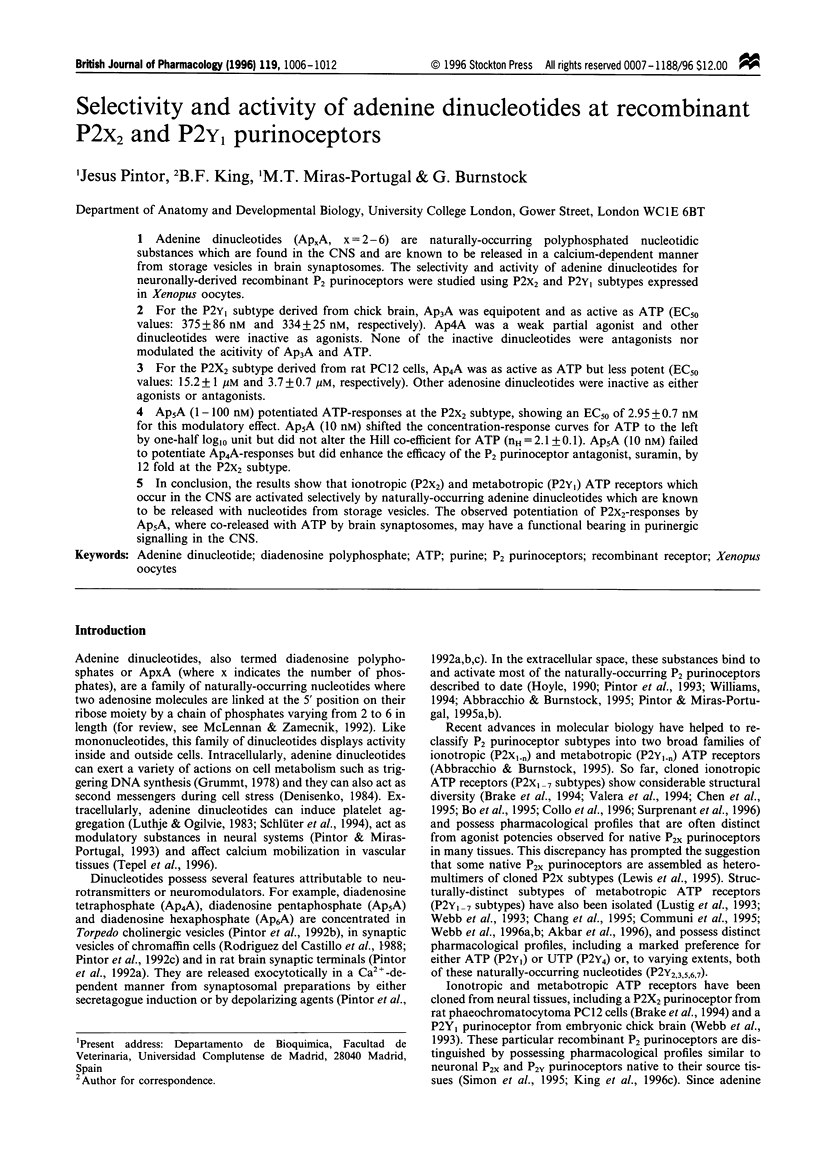
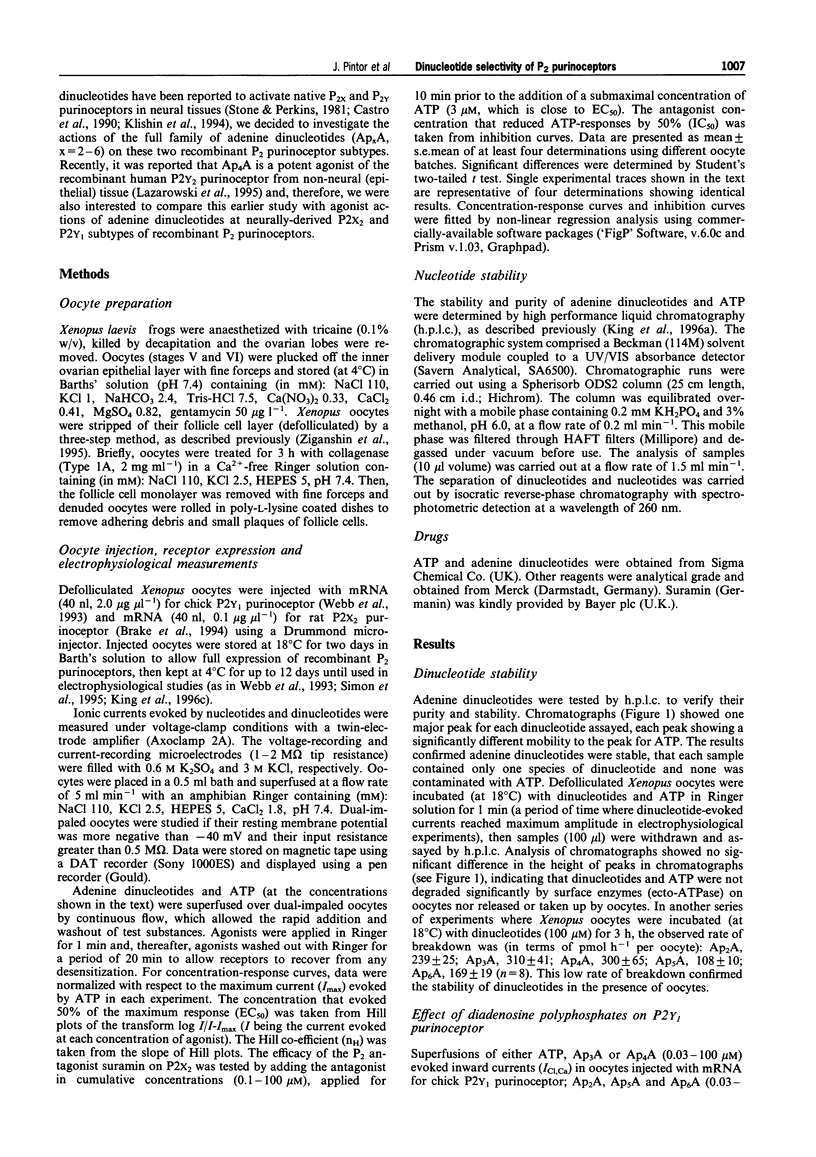
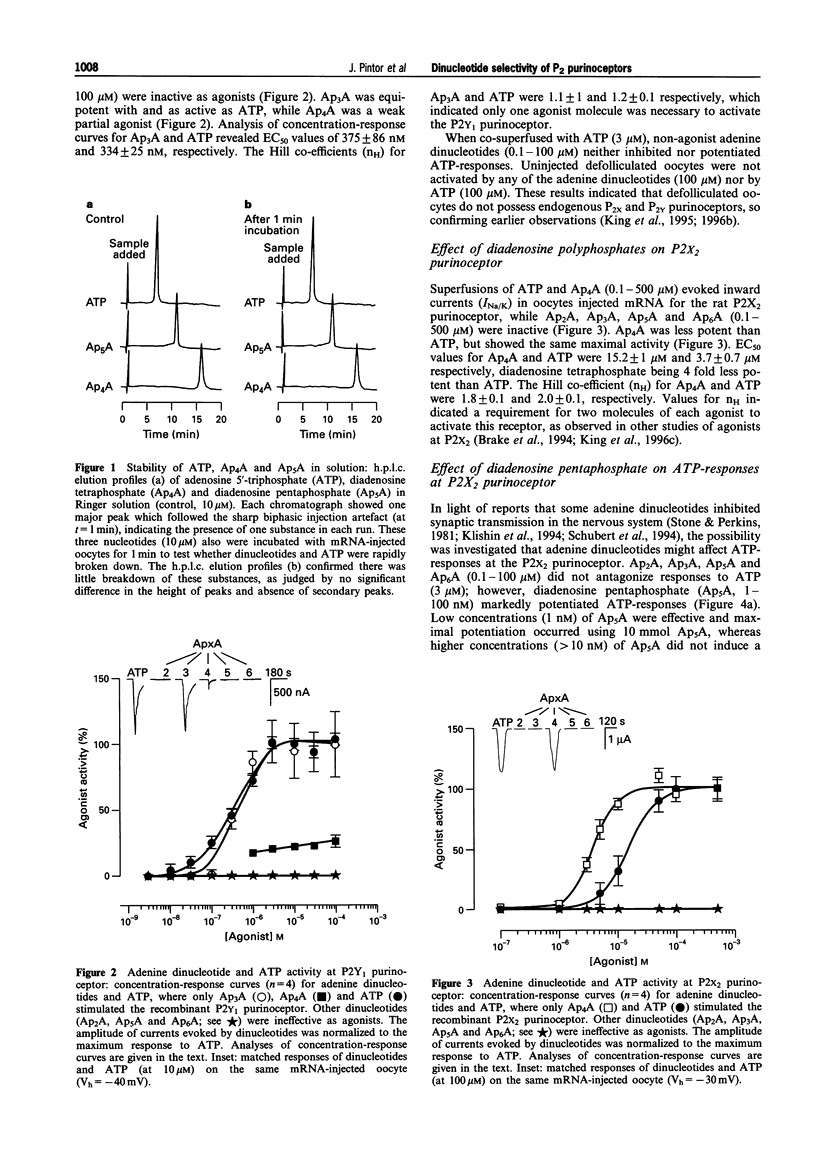

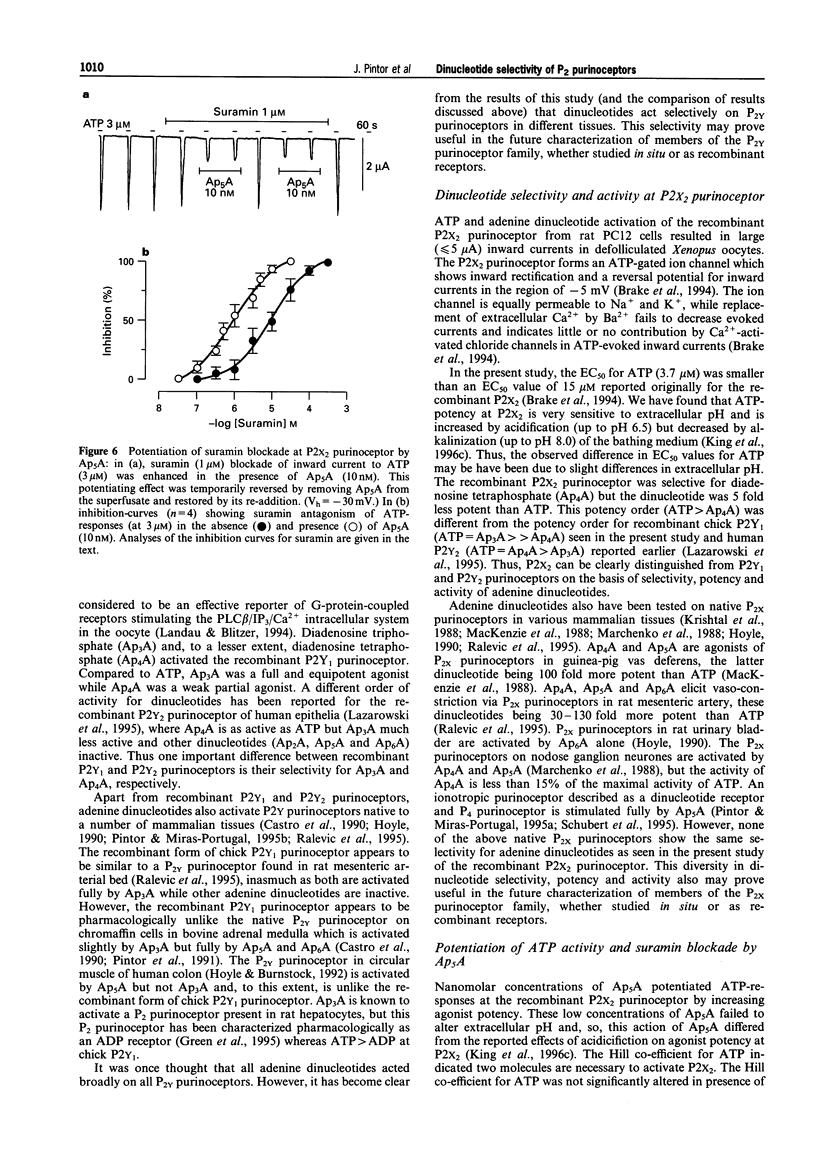
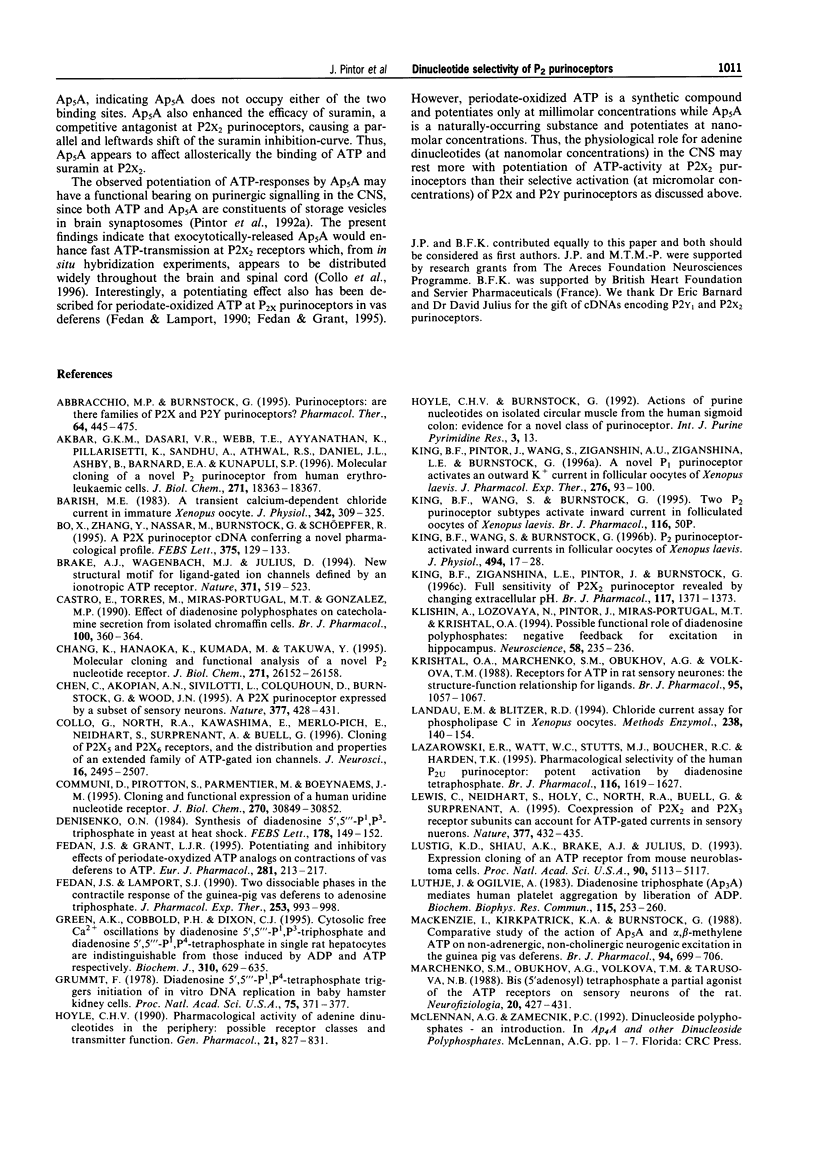
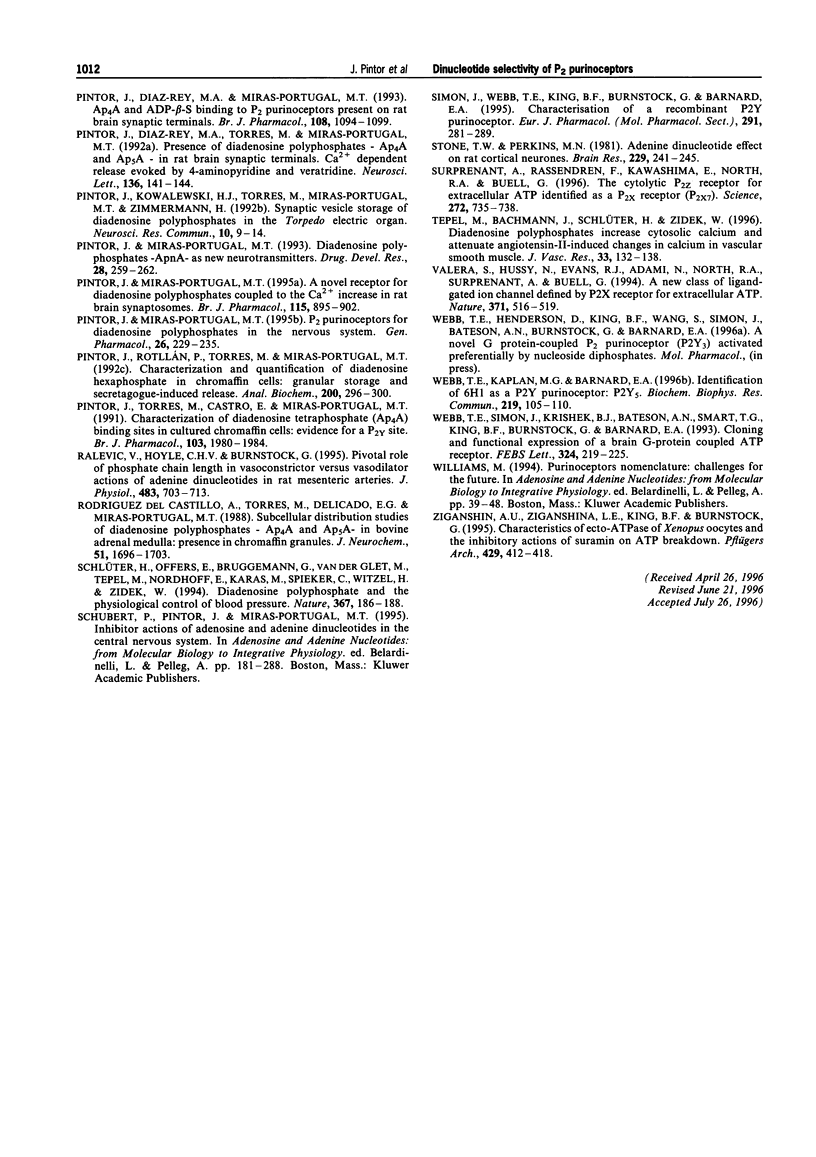
Selected References
These references are in PubMed. This may not be the complete list of references from this article.
- Abbracchio M. P., Burnstock G. Purinoceptors: are there families of P2X and P2Y purinoceptors? Pharmacol Ther. 1994;64(3):445–475. doi: 10.1016/0163-7258(94)00048-4. [DOI] [PubMed] [Google Scholar]
- Akbar G. K., Dasari V. R., Webb T. E., Ayyanathan K., Pillarisetti K., Sandhu A. K., Athwal R. S., Daniel J. L., Ashby B., Barnard E. A. Molecular cloning of a novel P2 purinoceptor from human erythroleukemia cells. J Biol Chem. 1996 Aug 2;271(31):18363–18367. doi: 10.1074/jbc.271.31.18363. [DOI] [PubMed] [Google Scholar]
- Barish M. E. A transient calcium-dependent chloride current in the immature Xenopus oocyte. J Physiol. 1983 Sep;342:309–325. doi: 10.1113/jphysiol.1983.sp014852. [DOI] [PMC free article] [PubMed] [Google Scholar]
- Bo X., Zhang Y., Nassar M., Burnstock G., Schoepfer R. A P2X purinoceptor cDNA conferring a novel pharmacological profile. FEBS Lett. 1995 Nov 13;375(1-2):129–133. doi: 10.1016/0014-5793(95)01203-q. [DOI] [PubMed] [Google Scholar]
- Brake A. J., Wagenbach M. J., Julius D. New structural motif for ligand-gated ion channels defined by an ionotropic ATP receptor. Nature. 1994 Oct 6;371(6497):519–523. doi: 10.1038/371519a0. [DOI] [PubMed] [Google Scholar]
- Castro E., Torres M., Miras-Portugal M. T., Gonzalez M. P. Effect of diadenosine polyphosphates on catecholamine secretion from isolated chromaffin cells. Br J Pharmacol. 1990 Jun;100(2):360–364. doi: 10.1111/j.1476-5381.1990.tb15809.x. [DOI] [PMC free article] [PubMed] [Google Scholar]
- Chang K., Hanaoka K., Kumada M., Takuwa Y. Molecular cloning and functional analysis of a novel P2 nucleotide receptor. J Biol Chem. 1995 Nov 3;270(44):26152–26158. doi: 10.1074/jbc.270.44.26152. [DOI] [PubMed] [Google Scholar]
- Chen C. C., Akopian A. N., Sivilotti L., Colquhoun D., Burnstock G., Wood J. N. A P2X purinoceptor expressed by a subset of sensory neurons. Nature. 1995 Oct 5;377(6548):428–431. doi: 10.1038/377428a0. [DOI] [PubMed] [Google Scholar]
- Collo G., North R. A., Kawashima E., Merlo-Pich E., Neidhart S., Surprenant A., Buell G. Cloning OF P2X5 and P2X6 receptors and the distribution and properties of an extended family of ATP-gated ion channels. J Neurosci. 1996 Apr 15;16(8):2495–2507. doi: 10.1523/JNEUROSCI.16-08-02495.1996. [DOI] [PMC free article] [PubMed] [Google Scholar]
- Communi D., Pirotton S., Parmentier M., Boeynaems J. M. Cloning and functional expression of a human uridine nucleotide receptor. J Biol Chem. 1995 Dec 29;270(52):30849–30852. doi: 10.1074/jbc.270.52.30849. [DOI] [PubMed] [Google Scholar]
- Fedan J. S., Grant L. J. Potentiating and inhibitory effects of periodate-oxidized ATP analogs on contractions of vas deferens to ATP. Eur J Pharmacol. 1995 Aug 4;281(2):213–217. doi: 10.1016/0014-2999(95)00352-l. [DOI] [PubMed] [Google Scholar]
- Fedan J. S., Lamport S. J. Two dissociable phases in the contractile response of the guinea pig isolated vas deferens to adenosine triphosphate. J Pharmacol Exp Ther. 1990 Jun;253(3):993–1001. [PubMed] [Google Scholar]
- Green A. K., Cobbold P. H., Dixon C. J. Cytosolic free Ca2+ oscillations induced by diadenosine 5',5"'-P1,P3-triphosphate and diadenosine 5',5"'-P1,P4-tetraphosphate in single rat hepatocytes are indistinguishable from those induced by ADP and ATP respectively. Biochem J. 1995 Sep 1;310(Pt 2):629–635. doi: 10.1042/bj3100629. [DOI] [PMC free article] [PubMed] [Google Scholar]
- Grummt F. Diadenosine 5',5'''-P1,P4-tetraphosphate triggers initiation of in vitro DNA replication in baby hamster kidney cells. Proc Natl Acad Sci U S A. 1978 Jan;75(1):371–375. doi: 10.1073/pnas.75.1.371. [DOI] [PMC free article] [PubMed] [Google Scholar]
- Hoyle C. H. Pharmacological activity of adenine dinucleotides in the periphery: possible receptor classes and transmitter function. Gen Pharmacol. 1990;21(6):827–831. doi: 10.1016/0306-3623(90)90440-w. [DOI] [PubMed] [Google Scholar]
- King B. F., Pintor J., Wang S., Ziganshin A. U., Ziganshina L. E., Burnstock G. A novel P1 purinoceptor activates an outward K+ current in follicular oocytes of Xenopus laevis. J Pharmacol Exp Ther. 1996 Jan;276(1):93–100. [PubMed] [Google Scholar]
- King B. F., Wang S., Burnstock G. P2 purinoceptor-activated inward currents in follicular oocytes of Xenopus laevis. J Physiol. 1996 Jul 1;494(Pt 1):17–28. doi: 10.1113/jphysiol.1996.sp021472. [DOI] [PMC free article] [PubMed] [Google Scholar]
- King B. F., Ziganshina L. E., Pintor J., Burnstock G. Full sensitivity of P2X2 purinoceptor to ATP revealed by changing extracellular pH. Br J Pharmacol. 1996 Apr;117(7):1371–1373. doi: 10.1111/j.1476-5381.1996.tb15293.x. [DOI] [PMC free article] [PubMed] [Google Scholar]
- Klishin A., Lozovaya N., Pintor J., Miras-Portugal M. T., Krishtal O. Possible functional role of diadenosine polyphosphates: negative feedback for excitation in hippocampus. Neuroscience. 1994 Jan;58(2):235–236. doi: 10.1016/0306-4522(94)90030-2. [DOI] [PubMed] [Google Scholar]
- Krishtal O. A., Marchenko S. M., Obukhov A. G., Volkova T. M. Receptors for ATP in rat sensory neurones: the structure-function relationship for ligands. Br J Pharmacol. 1988 Dec;95(4):1057–1062. doi: 10.1111/j.1476-5381.1988.tb11739.x. [DOI] [PMC free article] [PubMed] [Google Scholar]
- Landau E. M., Blitzer R. D. Chloride current assay for phospholipase C in Xenopus oocytes. Methods Enzymol. 1994;238:140–154. doi: 10.1016/0076-6879(94)38013-9. [DOI] [PubMed] [Google Scholar]
- Lazarowski E. R., Watt W. C., Stutts M. J., Boucher R. C., Harden T. K. Pharmacological selectivity of the cloned human P2U-purinoceptor: potent activation by diadenosine tetraphosphate. Br J Pharmacol. 1995 Sep;116(1):1619–1627. doi: 10.1111/j.1476-5381.1995.tb16382.x. [DOI] [PMC free article] [PubMed] [Google Scholar]
- Lewis C., Neidhart S., Holy C., North R. A., Buell G., Surprenant A. Coexpression of P2X2 and P2X3 receptor subunits can account for ATP-gated currents in sensory neurons. Nature. 1995 Oct 5;377(6548):432–435. doi: 10.1038/377432a0. [DOI] [PubMed] [Google Scholar]
- Lustig K. D., Shiau A. K., Brake A. J., Julius D. Expression cloning of an ATP receptor from mouse neuroblastoma cells. Proc Natl Acad Sci U S A. 1993 Jun 1;90(11):5113–5117. doi: 10.1073/pnas.90.11.5113. [DOI] [PMC free article] [PubMed] [Google Scholar]
- Lüthje J., Ogilvie A. The presence of diadenosine 5',5'''-P1,P3-triphosphate (Ap3A) in human platelets. Biochem Biophys Res Commun. 1983 Aug 30;115(1):253–260. doi: 10.1016/0006-291x(83)90997-x. [DOI] [PubMed] [Google Scholar]
- MacKenzie I., Kirkpatrick K. A., Burnstock G. Comparative study of the actions of AP5A and alpha,beta-methylene ATP on nonadrenergic, noncholinergic neurogenic excitation in the guinea-pig vas deferens. Br J Pharmacol. 1988 Jul;94(3):699–706. doi: 10.1111/j.1476-5381.1988.tb11578.x. [DOI] [PMC free article] [PubMed] [Google Scholar]
- Pintor J., Díaz-Rey M. A., Miras-Portugal M. T. Ap4A and ADP-beta-S binding to P2 purinoceptors present on rat brain synaptic terminals. Br J Pharmacol. 1993 Apr;108(4):1094–1099. doi: 10.1111/j.1476-5381.1993.tb13510.x. [DOI] [PMC free article] [PubMed] [Google Scholar]
- Pintor J., Díaz-Rey M. A., Torres M., Miras-Portugal M. T. Presence of diadenosine polyphosphates--Ap4A and Ap5A--in rat brain synaptic terminals. Ca2+ dependent release evoked by 4-aminopyridine and veratridine. Neurosci Lett. 1992 Mar 2;136(2):141–144. doi: 10.1016/0304-3940(92)90034-5. [DOI] [PubMed] [Google Scholar]
- Pintor J., Miras-Portugal M. T. A novel receptor for diadenosine polyphosphates coupled to calcium increase in rat midbrain synaptosomes. Br J Pharmacol. 1995 Jul;115(6):895–902. doi: 10.1111/j.1476-5381.1995.tb15894.x. [DOI] [PMC free article] [PubMed] [Google Scholar]
- Pintor J., Miras-Portugal M. T. P2 purinergic receptors for diadenosine polyphosphates in the nervous system. Gen Pharmacol. 1995 Mar;26(2):229–235. doi: 10.1016/0306-3623(94)00182-m. [DOI] [PubMed] [Google Scholar]
- Pintor J., Rotllán P., Torres M., Miras-Portugal M. T. Characterization and quantification of diadenosine hexaphosphate in chromaffin cells: granular storage and secretagogue-induced release. Anal Biochem. 1992 Feb 1;200(2):296–300. doi: 10.1016/0003-2697(92)90469-n. [DOI] [PubMed] [Google Scholar]
- Pintor J., Torres M., Castro E., Miras-Portugal M. T. Characterization of diadenosine tetraphosphate (Ap4A) binding sites in cultured chromaffin cells: evidence for a P2y site. Br J Pharmacol. 1991 Aug;103(4):1980–1984. doi: 10.1111/j.1476-5381.1991.tb12363.x. [DOI] [PMC free article] [PubMed] [Google Scholar]
- Ralevic V., Hoyle C. H., Burnstock G. Pivotal role of phosphate chain length in vasoconstrictor versus vasodilator actions of adenine dinucleotides in rat mesenteric arteries. J Physiol. 1995 Mar 15;483(Pt 3):703–713. doi: 10.1113/jphysiol.1995.sp020615. [DOI] [PMC free article] [PubMed] [Google Scholar]
- Rodriguez del Castillo A., Torres M., Delicado E. G., Miras-Portugal M. T. Subcellular distribution studies of diadenosine polyphosphates--Ap4A and Ap5A--in bovine adrenal medulla: presence in chromaffin granules. J Neurochem. 1988 Dec;51(6):1696–1703. doi: 10.1111/j.1471-4159.1988.tb01147.x. [DOI] [PubMed] [Google Scholar]
- Schlüter H., Offers E., Brüggemann G., van der Giet M., Tepel M., Nordhoff E., Karas M., Spieker C., Witzel H., Zidek W. Diadenosine phosphates and the physiological control of blood pressure. Nature. 1994 Jan 13;367(6459):186–188. doi: 10.1038/367186a0. [DOI] [PubMed] [Google Scholar]
- Simon J., Webb T. E., King B. F., Burnstock G., Barnard E. A. Characterisation of a recombinant P2Y purinoceptor. Eur J Pharmacol. 1995 Nov 30;291(3):281–289. doi: 10.1016/0922-4106(95)90068-3. [DOI] [PubMed] [Google Scholar]
- Stone T. W., Perkins M. N. Adenine dinucleotide effects on rat cortical neurones. Brain Res. 1981 Dec 14;229(1):241–245. doi: 10.1016/0006-8993(81)90764-2. [DOI] [PubMed] [Google Scholar]
- Surprenant A., Rassendren F., Kawashima E., North R. A., Buell G. The cytolytic P2Z receptor for extracellular ATP identified as a P2X receptor (P2X7). Science. 1996 May 3;272(5262):735–738. doi: 10.1126/science.272.5262.735. [DOI] [PubMed] [Google Scholar]
- Tepel M., Bachmann J., Schlüter H., Zidek W. Diadenosine polyphosphates increase cytosolic calcium and attenuate angiotensin-II-induced changes of calcium in vascular smooth muscle cells. J Vasc Res. 1996 Mar-Apr;33(2):132–138. doi: 10.1159/000159141. [DOI] [PubMed] [Google Scholar]
- Valera S., Hussy N., Evans R. J., Adami N., North R. A., Surprenant A., Buell G. A new class of ligand-gated ion channel defined by P2x receptor for extracellular ATP. Nature. 1994 Oct 6;371(6497):516–519. doi: 10.1038/371516a0. [DOI] [PubMed] [Google Scholar]
- Webb T. E., Kaplan M. G., Barnard E. A. Identification of 6H1 as a P2Y purinoceptor: P2Y5. Biochem Biophys Res Commun. 1996 Feb 6;219(1):105–110. doi: 10.1006/bbrc.1996.0189. [DOI] [PubMed] [Google Scholar]
- Webb T. E., Simon J., Krishek B. J., Bateson A. N., Smart T. G., King B. F., Burnstock G., Barnard E. A. Cloning and functional expression of a brain G-protein-coupled ATP receptor. FEBS Lett. 1993 Jun 14;324(2):219–225. doi: 10.1016/0014-5793(93)81397-i. [DOI] [PubMed] [Google Scholar]
- Ziganshin A. U., Ziganshina L. E., King B. E., Burnstock G. Characteristics of ecto-ATPase of Xenopus oocytes and the inhibitory actions of suramin on ATP breakdown. Pflugers Arch. 1995 Jan;429(3):412–418. doi: 10.1007/BF00374157. [DOI] [PubMed] [Google Scholar]


